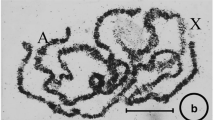Abstract
The sex chromosomes evolved from a pair of autosomes that deviated over a period of time, with one chromosome losing most of its genes. In many animal groups, females have two X-chromosomes—a large chromosome with numerous genes. Males have one X and a Y chromosome, which has lost most genes except those involved in sex determination and fertility. Thus males are effectively monosomic for the X-chromosome. Monosomy being lethal for other chromosomes, organisms evolved a mechanism called ‘dosage compensation’ (DC) which quantitatively equalizes X-linked gene products between the sexes, compensating for their numerical disparity (dosage). Best studied in Drosophila, Caenorhabditis elegans, and mammals, different species adopt different mechanisms of DC. In Drosophila, genes on the male X-chromosome are twice as active as on each X-chromosome in females. In C. elegans, DC is achieved by the lowered activity of each X-chromosome in XX individuals vis-a-vis the male X. In mammals, the inactivation of an entire X-chromosome in the female results in the parity between the two sexes. Despite the difference in gross mechanisms, the molecular processes achieving DC are uniform due to chromatin modifications (histone acetylation, methylation, and DNA methylation) and synthesis of various noncoding RNAs (lncRNAs). Together, they regulate the X-chromosome activity. In mammals, a lncRNA from the inactive X—XIST (X-inactive specific transcript)—binds with the same X to initiate inactivation. X-chromosome inactivation (XCI) in humans reveals interesting mechanisms for en bloc regulation of gene function, as well as modifiers of Mendelian inheritance patterns in genetic disorders.
Similar content being viewed by others
Suggested Reading
Curt Stern, Dosage compensation: Development of a concept and new facts, Can. J. Genet. Cytol., Vol.2, pp.105–118, 1960.
Ardhendu S Mukherjee, Wolfgang Beermann, Synthesis of ribonucleic acid by the X-chromosome of Drosophila melnogaster and the problem of dosage compensation, Nature, Vol.207, pp.785–786, 1965.
Ursula Mittwoch, Sex chromatin, J. Med. Genet., Vol.1, pp.50–76, 1964.
Mary F Lyon, Gene action in the X-chromosome of the mouse (Mus musculus L), Nature, Vol.190, pp.372–373, 1961.
Christine M Disteche, Joel B Berletch, X-chromosome inactivation and escape, J. Genet., Vol.94, No.4, pp.591–599, 2015.
Barbara J Meyer, L P Casson, Caenorhabditis elegans compensates for the difference in X-chromosome dosage between the sexes by regulating transcript levels, Cell, Vol.47, pp.871–881, 1986.
Sarah Elizabeth Albritton, Sevinc Ercan, Caenorhabditis elegans dosage compensation: Insights into condensin-mediated gene regulation, Trends in Genetics, Vol.34, pp.41–53, 2018.
Catherine Patrat, Jean-Francois Ouimette, Claire Rougeulle, X-chromosome inactivation in human development, Development, doi https://doi.org/10.1242/dev.183095 2020.
John Lucchesi Transcriptional modulation of entire chromosomes: dosage compensation, J. Genet., Vol.97, pp.257–364, 2018.
Murray L Barr, E G Bertram, A morphological distinction of the male and female, and the behavior of the nucleolar satellite during accelerated nucleo-protein synthesis, Nature, Vol.163, p.676, 1949.
Acknowledgement
I record my deep sense of appreciation to those tens of hundreds of students, whom I have had the privilege of teaching in classrooms and who have responded with interest, curiosity, and innovative ideas. I am deeply thankful to Prof. Vidynanda Nanjundiah, IISc, Bangalore, Dr Indrajit Nanda, Wurzburg, Germany, and Prof. Mahesh Sharma, M.S. College, Saharanpur, Meerut University, for critical appraisal of the manuscript in its formative stage. Springer is thanked for the permission to reproduce Figures 2 & 3 from J. Genetics. The karyotypes are of the cases studied in the Centre for Genetic Disorders, Banaras Hindu University.
Author information
Authors and Affiliations
Corresponding author
Additional information
Rajiva Raman had his university education from Banaras Hindu University. After his retirement from the Department of Zoology at BHU as Professor, he is now serving in the same department as Distinguished Professor. He is also the Senior Scientist of the Indian National Science Academy. He has a teaching experience of nearly 40 years.
Rights and permissions
About this article
Cite this article
Raman, R. Dosage Compensation. Reson 26, 649–669 (2021). https://doi.org/10.1007/s12045-021-1167-3
Published:
Issue Date:
DOI: https://doi.org/10.1007/s12045-021-1167-3



